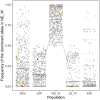The New Is Old: Novel Germination Strategy Evolved From Standing Genetic Variation in Weedy Rice
- PMID: 34234803
- PMCID: PMC8256273
- DOI: 10.3389/fpls.2021.699464
The New Is Old: Novel Germination Strategy Evolved From Standing Genetic Variation in Weedy Rice
Abstract
Feralization of crop plants has aroused an increasing interest in recent years, not only for the reduced yield and quality of crop production caused by feral plants but also for the rapid evolution of novel traits that facilitate the evolution and persistence of weedy forms. Weedy rice (Oryza sativa f. spontanea) is a conspecific weed of cultivated rice, with separate and independent origins. The weedy rice distributed in eastern and northeastern China did not diverge from their cultivated ancestors by reverting to the pre-domestication trait of seed dormancy during feralization. Instead, they developed a temperature-sensing mechanism to control the timing of seed germination. Subsequent divergence in the minimum critical temperature for germination has been detected between northeastern and eastern populations. An integrative analysis was conducted using combinations of phenotypic, genomic and transcriptomic data to investigate the genetic mechanism underlying local adaptation and feralization. A dozen genes were identified, which showed extreme allele frequency differences between eastern and northeastern populations, and high correlations between allele-specific gene expression and feral phenotypes. Trancing the origin of potential adaptive alleles based on genomic sequences revealed the presence of most selected alleles in wild and cultivated rice genomes, indicating that weedy rice drew upon pre-existing, "conditionally neutral" alleles to respond to the feral selection regimes. The cryptic phenotype was exposed by activating formerly silent alleles to facilitate the transition from cultivation to wild existence, promoting the evolution and persistence of weedy forms.
Keywords: crop feralization; germination strategy; rapid adaptation; standing genetic variation; weedy rice.
Copyright © 2021 Zhou, Feng, Li, Wang, Jian, Wang, Zhang, Song, Li, Lu and Yang.
Conflict of interest statement
The authors declare that the research was conducted in the absence of any commercial or financial relationships that could be construed as a potential conflict of interest.
Figures




Similar articles
-
The Role of Standing Variation in the Evolution of Weedines Traits in South Asian Weedy Rice (Oryza spp.).G3 (Bethesda). 2018 Nov 6;8(11):3679-3690. doi: 10.1534/g3.118.200605. G3 (Bethesda). 2018. PMID: 30275171 Free PMC article.
-
Diverse genetic mechanisms underlie worldwide convergent rice feralization.Genome Biol. 2020 Mar 26;21(1):70. doi: 10.1186/s13059-020-01980-x. Genome Biol. 2020. PMID: 32213201 Free PMC article.
-
Genomic divergence during feralization reveals both conserved and distinct mechanisms of parallel weediness evolution.Commun Biol. 2021 Aug 10;4(1):952. doi: 10.1038/s42003-021-02484-5. Commun Biol. 2021. PMID: 34376793 Free PMC article.
-
African Cultivated, Wild and Weedy Rice (Oryza spp.): Anticipating Further Genomic Studies.Biology (Basel). 2024 Sep 5;13(9):697. doi: 10.3390/biology13090697. Biology (Basel). 2024. PMID: 39336124 Free PMC article. Review.
-
Fitness correlates of crop transgene flow into weedy populations: a case study of weedy rice in China and other examples.Evol Appl. 2016 Mar 31;9(7):857-70. doi: 10.1111/eva.12377. eCollection 2016 Aug. Evol Appl. 2016. PMID: 27468304 Free PMC article. Review.
Cited by
-
Bray-Curtis (AFD) differentiation in molecular ecology: Forecasting, an adjustment ( A A), and comparative performance in selection detection.Ecol Evol. 2022 Sep 11;12(9):e9176. doi: 10.1002/ece3.9176. eCollection 2022 Sep. Ecol Evol. 2022. PMID: 36110882 Free PMC article.
-
An Unexplored Diversity for Adaptation of Germination to High Temperatures in Brassica Species.Evol Appl. 2025 Mar 9;18(3):e70089. doi: 10.1111/eva.70089. eCollection 2025 Mar. Evol Appl. 2025. PMID: 40066327 Free PMC article.
-
Genetic Diversity of Transcription Factor Genes in Triticum and Mining for Promising Haplotypes for Beneficial Agronomic Traits.Front Plant Sci. 2022 Jul 8;13:899292. doi: 10.3389/fpls.2022.899292. eCollection 2022. Front Plant Sci. 2022. PMID: 35873966 Free PMC article.
-
Comparison of leaf anatomical structure and photosynthetic characteristics between weedy rice and cultivated rice at the seedling stage.Sci Rep. 2024 Dec 28;14(1):30829. doi: 10.1038/s41598-024-81669-4. Sci Rep. 2024. PMID: 39730556 Free PMC article.
References
-
- Bauer N., Skiljaica A., Malenica N., Razdorov G., Klasic M., Juranic M., et al. . (2019). The MATH-BTB protein TaMAB2 accumulates in ubiquitin-containing foci and interacts with the translation initiation machinery in Arabidopsis. Front. Plant Sci. 10:1469. 10.3389/fpls.2019.01469 - DOI - PMC - PubMed
LinkOut - more resources
Full Text Sources

